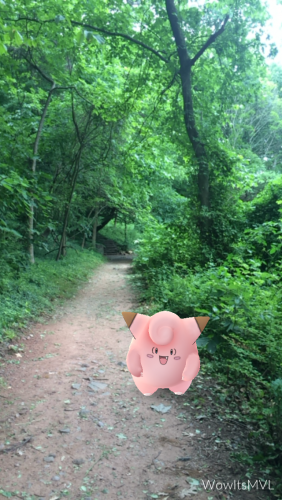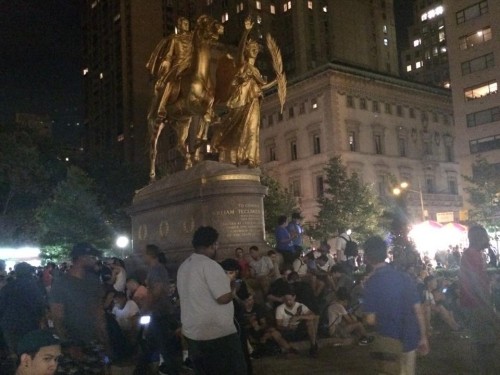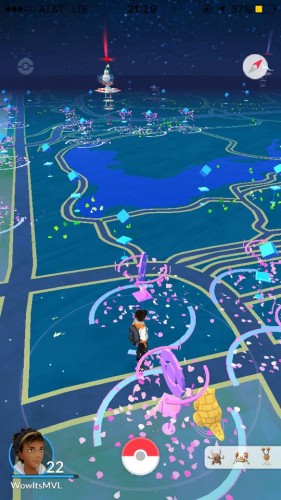My mom and I spent some part of the 1995 summer with my aunt and her house, complete with backyard. I was three, and having lived most of my life in a small New York studio apartment, my mom must’ve thought I would enjoy the few elements of nature often found in quiet Californian suburbs. She was wrong: each time they tried setting me in the grass, I would crawl desperately back to the beautiful, safe, concrete patio.
This is a childhood story that still speaks to my identity: camping is not my first choice of activities, and the narratives of people who lose themselves in the wilderness are tedious to me. So it was quite a surprise when I willing accepted the hiking trail Pokémon Go had set for me with the promise of Clefairies:
That Pokémon Go managed this feat is a miracle, and betrays my investment in the game. Pokémon celebrates its 20th birthday this year; in those twenty years, a generation of young adults grew up building the Pokémon World over kitchen tables and in parks. Anthropologist Anne Allison described Pokémon’s designers as part of a trend in game design through the 90s that used cheaper digital technology to resolve the increasing isolation of children. If children couldn’t fit friends into the regimented schedule of school, extracurriculars, and sleep, then companies could sell games that made friends portable and accessible on each child’s schedule.
Although Pokémon started as corporate code, demand soon outstripped Nintendo’s capacity to produce Pokémon. Unlicensed merchandise and cards spawned anywhere demand existed. These days, Pokémon has its own search tag on most porn sites, and is comfortably in the top 10 of FanFiction fandoms. In 2014, a cult quickly developed around Twitch Plays Pokémon: an event in which some hundred thousand players worked together to complete Pokémon: Red Version, through Twitch.TV’s chat screen. Playing Pokémon––whether at the kitchen table, at recess, or after school––has become a collective act of participation. The French sociologist Èmile Durkheim would have called it the collective effervescence of the 1990s: an activity as much about the affect and socialization produced as it was about the game. Nintendo may have designed it, but people made it real.
It’s no accident that most people who register critiques of the game are left with bemusement at why the game captivates: the game’s immersion has incorporated the previous efforts of players in the Pokémon world. Sam Kriss at Jacobin takes the game to task for another reason: it crashes through our reality, displacing it with an “objective fantasy” where all possible routes are already mapped. In other words, the game pretends to provide you with a fantastical world, but actually is strictly regimented access to everyday, physical space.
In some ways, Kriss is correct in his assessment. While the game offers the potential to live a child’s dream as an adult, it does so with specific paths laid out, and thus sharply limits the imaginative prowess. This is especially true with the placement of PokéStops. PokéStops serve two important functions in the game: They allow players to obtain items without paying for the in-game currency (this is, after all, a Freemium game), and they allow for the use of PokéLures, an item that draws wild Pokémon to the location of the PokéStop for thirty minutes. The promise of easily attainable Pokémon, made visible by petals falling from the stop’s icon, inevitably lures players as consistently as they do Pokémon. And when multiple PokéLures are used in close proximity, groups of strangers suddenly talk to each other with a common vocabulary; between bouts of excited shouting about the rare Pokémon that just flashed on everyone’s screens.
PokéLures are the heart that drives socializing in the game. They’re a new coffeehouse or bar: one shows up on my screen, followed quickly by another right across the street, and I know that I’ll run into the set of players I’ve met at similar setups of PokéLures. Conversations often run between local events in New Haven, and rumors of Pokémon spot in specific regions: “Yeah, West Haven is full of Jynx at night,” someone tells me. Dammit, I think to myself. I’d need a car to get there.
I’m fortunate that playing is an option at all: PokéStops and their Lures are usually associated with spaces that have “cultural significance.” Art installations, interesting historical landmarks, or monuments, criterion that often end up placing them in a critical mass within cities. Some players have said they have to drive ten minutes before finding a single PokéStop. Meanwhile, on a recent trip to New York, a friend told me the 13-15 PokéLures set up within a five minute radius was a “slow” night for Pokémon in Central Park.
And yet, even critiques like Kriss’ rely on a simplified relationship between players and rules. We are describing vast swathes of the population, many of whom play the game for their own purposes. Attempting to categorize all experiences as a single perspective of purpose risks reframing Pokémon Go as another product of an ill-defined mass culture. In the mid-twentieth century, cultural studies studies––studying the heterogeneity of culture and cultural reception––was born to push against the anxiety of the atomized individual, found in many critiques of mass culture.
But Pokémon Go neither suspends nor homogenizes the problems of identity in twenty-first century America. Maddy Myers anticipates that “Are you playing Pokémon Go?” will become one of the hottest pick-up lines of 2016; PokéMatch appears to validate her concerns. The timing of Pokémon Go’s release––in the aftermath of America reeling after the footage of Alton Sterling and Philando Castile, dying, as a result of municipal police––has made the game a debate between escapism from brutal atrocities and the fact that such escapism is limited by realistic expectations of safety for Black folks while playing the game. Just as some people “escape” by the spectacle on their screens, so do others negotiate these issues as part of the experience of play.
Critiques of mass culture also found trouble in their excessive reliance on the structure set by rules: it denied the possibility of resistance. If the rules of Pokémon Go are so objectively fixed, there is little hope of using the game for anything more than the game’s designated purpose. This interpretation of cultural limitations is what the Marxist philosopher Henri Lefebvre resists in his text The Production of Space. Lefebvre viewed the triumph of “mental space” (that of theorizing, of reading, of rulemaking) over “physical space” (where we eat, sleep, and play) as nonsensical and unsubstantiated. While Lefebvre’s main target were those philosophers of language, who collapsed the mental space into the words that formed it, Lefebvre suggests that mental space and physical space cannot be understood as two halves: they must be evaluated as a single system.
Many players of Pokémon Go take the rules and goals of the game as suggestions. While the game suggests you “catch ‘em all,” some players are content with making fun of the game’s inability to produce more than Weedles, Pidgeys and Rattatas. A whole new set of memes and macros used to convey disappointment, anger, and general absurdity take advantage of the universal experience that is only finding these three Pokémon almost anywhere.
But, even while playing the game seriously, players are more heterogenous than anything else. Some players catch the cute Pokémon; some players catch the Fire types; others play to socialize with friends. It is these heterogenous experiences that structure Alexandra Samuel’s evaluation of the games cartographic implications. A key detail is the map’s overlay and the information it lacks:
“In the case of Pokémon Go, the most noteworthy feature is the absence of any street names: your only navigation clues are nameless blocks and intersections and named landmarks. This makes Pokémon Go far closer to pre-cartographic navigation by landmark than to modern wayfinding via street names and addresses.”
The intent to take away information––cross streets, or traffic patterns––goes directly against Google Map’s project to make travel from Point A to Point B as efficient as possible. If you want to hit up Gyms, or find PokéLures, a player must be willing to add five or ten minutes to a route. The reward, of course, might include levelling in the game. But it might also include meeting the group of players whose company you enjoyed at the past two PokéLures. My hike was only one of several neighborhood excursions, motivated by people I’d met at the Lures, excitedly describing what they’d found, and where they’d met other players. Building my piece of this new Pokémon world, hanging out with a group of Pokémon trainers I would never have met otherwise, and exploring the entirety of New Haven’s offerings have left me with a new map of the city, one much more memorable than would have been possible otherwise.
Much like any facet of American culture in the twenty first century, the game is playable to the extent that someone wants to participate in American society. Pokémon Go is neither a messianic salvation, nor is it an apocalyptic nightmare. It’s a game whose possibilities of resistance and compliance are found with the people who interact with it.
Marley-Vincent Lindsey is a PhD student at Brown, where he works on religion, economics, and ideas between Spain and Latin America in the sixteenth century. He uses this experience to ask what is new and old about human beings on the web, a question that is very dear to him. He occasionally tweets.




